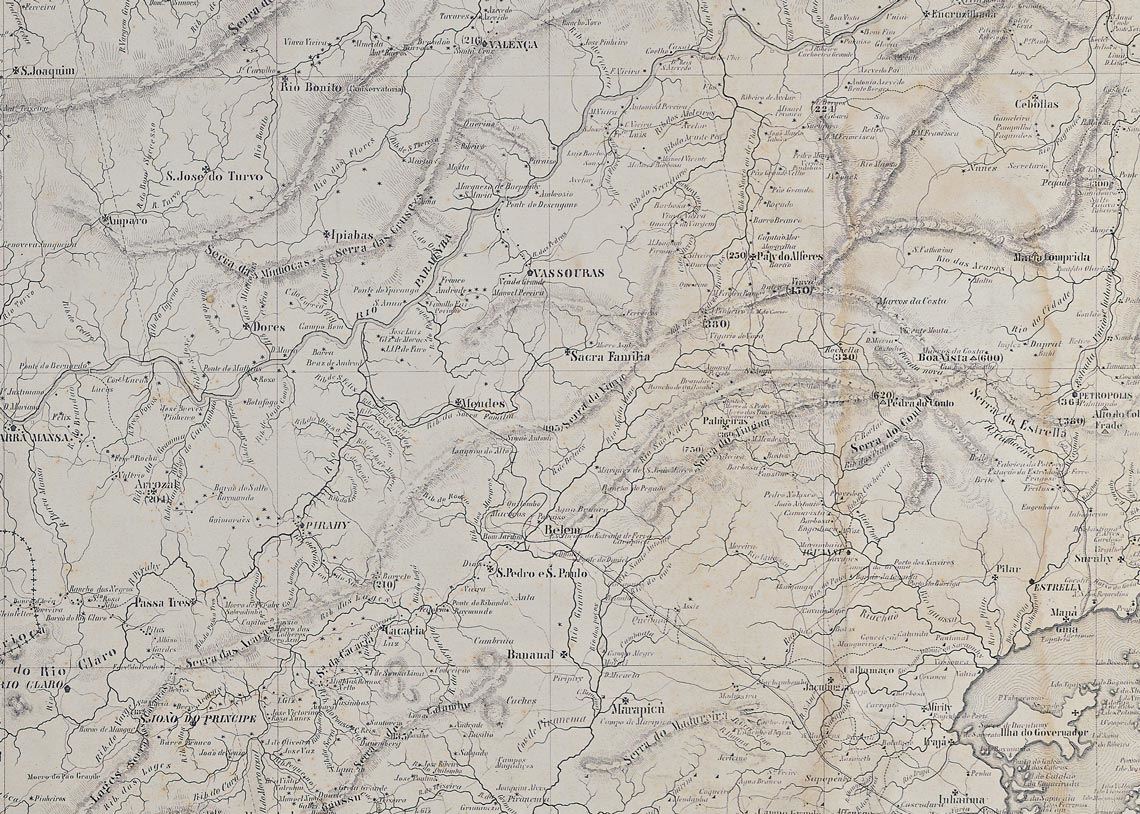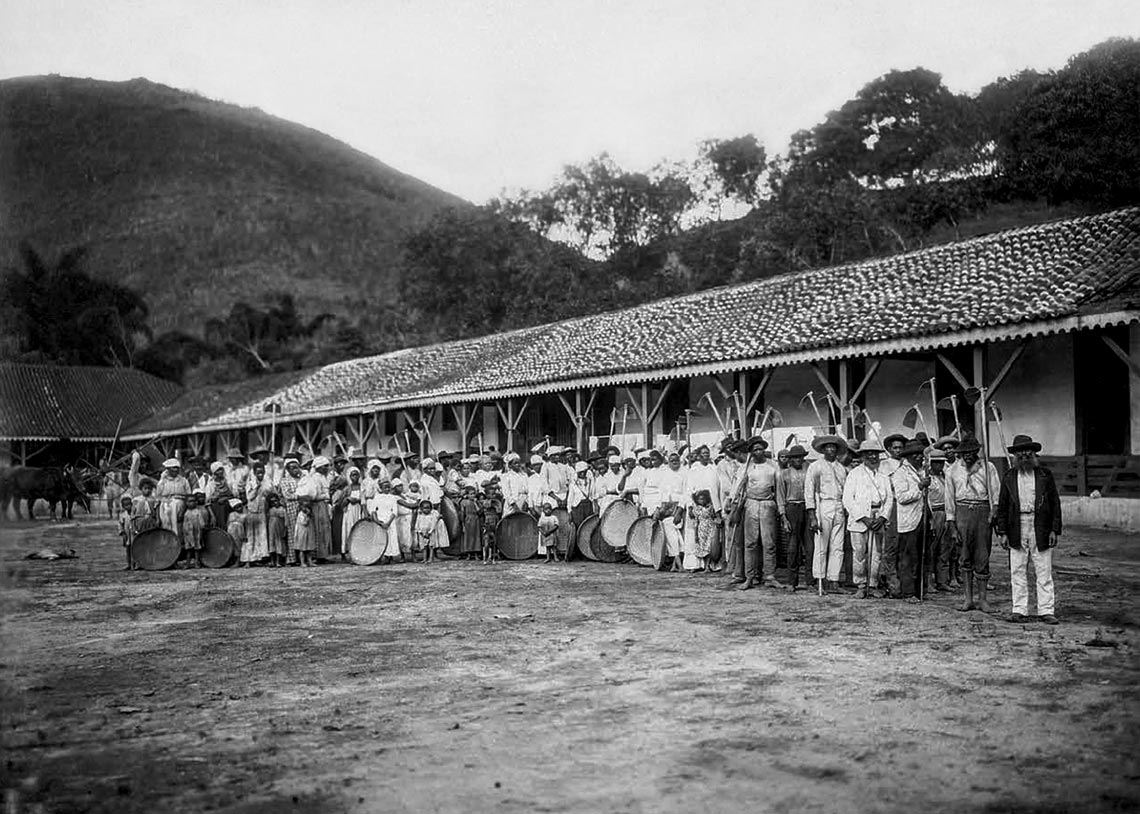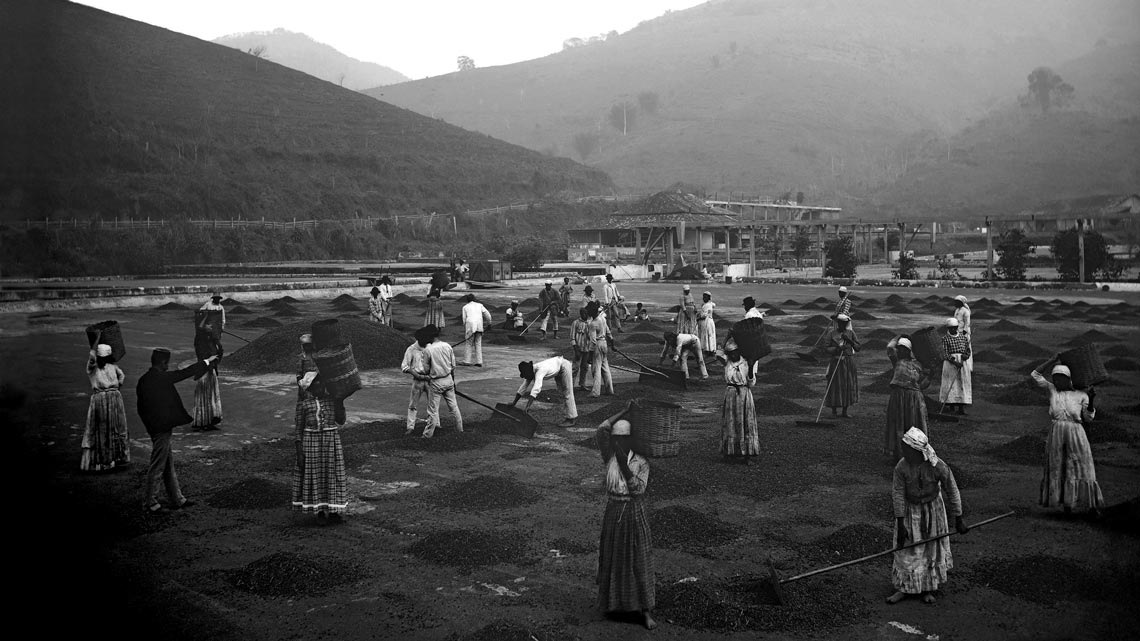The nineteenth century brought with it changes so profound that they left visible marks. In Europe, the industrial revolution led to factories that could produce items at an unprecedented rate and increased the demand for imported raw materials. Railroads crisscrossed the countryside and smokestacks pierced urban horizons. The vast territories of the colonies and former colonies that supplied the Old Continent also underwent major transformations, both in land use and forms of labor, leaving marks that can be seen in the images produced at the time.
According to historian Rafael de Bivar Marquese, from the School of Philosophy, Languages and Literature, and Humanities at the University of São Paulo (FFLCH-USP), traces of this process can be seen in maps, blueprints, paintings, and photographs. The iconography reveals an increasing rationalization of space at the time when agricultural production had to be expanded rapidly. The documents, which include inventories, administrative documents, minutes of proceedings of legislative assemblies, and even manuals on the management of plantations that used slave labor, shed light on how slave owners put their captives to work.
In the book Reconstructing the landscapes of slavery, Marquese—alongside American historian and sociologist Dale Tomich, of Binghamton University, and Cuban historians Reinaldo Funes Monzote of the University of Havana and Carlos Venegas Fornias of the Centro de Investigaciones Juan Marinello—analyze these transformations in landscape and labor. The authors examine several types of images depicting the changes in space and labor exploitation in three areas known for agricultural production in the Americas: the Paraíba Valley, where coffee cultivation was beginning to expand; the Mississippi River Valley, in southern United States, where cotton plantations were a frontier of westward expansion; and the sugarcane plains of western Cuba, a key colony of Spain until the beginning of the nineteenth century.
The book illustrates how the exploitation of enslaved persons—an element of the economic rationality that was taking over the world—changed over time. According to Marquese, until the seventeenth century, the concept of slave labor followed the same logic as the ancient treatises on agronomy and economy, which focused on managing the house first, and production second. “In the eighteenth century, with the establishment of the political economy, economic discourse became autonomous,” he says. The market expanded at a rapid pace, and productivity became key. In response, land, labor, and money became factors of production.
“After this takes place, we are able to document how the thinking and practices of slave owners changed with regards to the labor of the enslaved, seen as a source of value creation. The management of this labor also changed: mechanisms were created to extract more labor from people and more product from nature,” Marquese points out. To describe the change in the logic of production regarding enslaved people, Tomich coined the expression “second slavery,” embraced by Marquese and other Brazilian scholars.
Concentration and intensification
The first half of the nineteenth century saw a shift in global coffee production to Brazil, due to a series of crises in the Caribbean and the independence of Haiti (1804), which housed the world’s coffee plantations up until that point. The result was a series of impactful changes in agricultural production. In Vassouras, a key coffee plantation area in Rio de Janeiro during the first decades of the coffee cycle, 9% of slave owners were found to own 48% of enslaved persons; they are referred to as “mega-owners.” Coffee growers were pushed to expand production and increase labor productivity so they could meet the demands of a rapidly growing market.
An observable effect of the new role of the Paraiba Valley in the international market was the concentrated ownership of enslaved individuals. The process was studied in the local archives by a researcher from Marquese’s team, PhD student Breno Servidone Moreno, who compared the demographic pattern of the former French colony of Santo Domingo (now Haiti and the Dominican Republic), at the peak of its coffee production during the second half of the eighteenth century, to what was practiced in this region of Brazil during the mid-nineteenth century. On the Caribbean island, 26% of slave owners owned 61% of enslaved people. In Bananal, in the state of São Paulo—the area analyzed by Moreno, 21% of owners had 80% of the enslaved population.
The size of the properties was also different. In Santo Domingo, the average size was 145 hectares. In Bananal, it was more than twice as large: 397 hectares. The Bananal numbers are similar to the known data for Vassouras and Cantagalo, in Rio de Janeiro, and are considered representative for the Paraíba Valley. In Santo Domingo, each enslaved individual would produce, on average, about 220 kilograms (kg) of coffee a year. In Bananal, in 1854, each person produced 1,270 kg of coffee per year.

National Library of Brazil / Rio de Janeiro
Detail of a map of the Rio de Janeiro province, drawn up in 1861 by engineers Pedro d’Alcantra Bellegarde and Conrado Jacob de Niemeyer. It portrays the area dedicated to coffee growing on an unprecedented scale, in the central Paraíba ValleyNational Library of Brazil / Rio de JaneiroThe restrictions on the slave trade and the demands of the market also had an impact on science and medicine, says historian Iamara da Silva Viana, a professor at the Pontifical Catholic University of Rio de Janeiro (PUC-RJ) and the Rio de Janeiro State University (UERJ). Medical knowledge specific to the bodies of enslaved persons was developed, clearly expressed in the Manual do fazendeiro ou tratado doméstico sobre as enfermidades dos negros (Farmer’s manual or domestic treatise on the illnesses of Black people), published by Frenchman Jean-Baptiste Alban Imbert in the 1830s, which Viana has studied in detail.
“It was about caring for enslaved bodies to maximize their use, at a time of economic expansion and massive influx of Africans. The body of the enslaved was scrutinized to meet economic and political demands. Imbert describes the enslaved body as value, investment, and labor force,” Viana summarizes.
Around this time, Brazil supplied half of the world’s coffee production. The Paraíba Valley, which had up until then been occupied by small family farms, began to house large-scale coffee farms that were heavily dependent on the labor of the enslaved.
“On one hand, what motivated us to write this book was the plantation landscapes transforming into labor sites. But we also wanted to examine the images, maps, photographs, oil paintings, etc. as elements that not only represented realities, but also interfered with how the material space was organized, introducing modifications,” summarizes Marquese. He explains that the modern concept of landscape is a product of the Renaissance, as is the notion of perspective.
Marquese claims iconographic analysis is relevant because landscapes emerged as a way not only to view the physical world, but also to control it, through their codified display from a single, dominating point of view. This is when the world begins to be seen through the lens of mathematics, with “an impulse to impose order on one’s surroundings and resources,” he states. At the same time, “it is a way to represent environments with an organization that is both symbolic and material: by interpreting the world in this way, the opposite also becomes true, because the representation also organizes the physical space,” he says. This is why representation was a fundamental element of colonialism, which produced “layers and layers of maps of urban and rural spaces, rationalizing the territory of the colonies.”
The availability of the images varies from country to country and is indicative of political and historical circumstances. A detail that caught the researchers’ attention was the scarcity of maps and topographical representations of Brazilian farms, compared to how many such documents exist for Cuba and the Mississippi region. There is an “enormous wealth of images” on the Caribbean island because strict control over the topographical limits of each property was essential to maintain the power of the Spanish Crown, since the Caribbean island was one of its last colonial possessions and the wealthiest. In the United States, the main motivation was advancing the frontier, which was accomplished by privatizing land through public sales, which required prior mapping.
“There are no maps of the Paraíba Valley farms from around this time. We searched desperately, everywhere; all we found was a map of the land in the nineteenth century, which doesn’t even show the boundaries of the properties,” says Marquese. The historian claims the reason for this scarcity in Brazil lies in the concentration of political power in the hands of coffee barons and slave owners. “The farmers were not interested in mapping or counting their properties. They preferred to resolve whatever conflicts arose amongst themselves. The lack of maps is a deliberate choice. The country leaned heavily on the illegal slave trade,” he observes.
Most of the farm images in the book are photographs by Marc Ferrez (1843–1923), taken in the 1880s, the last decade of slavery (see Pesquisa FAPESP issue nº 281). Although they are from a different time, when the coffee-growing frontier had moved to the west of São Paulo, the images of the farms in the Paraíba Valley, depicting enslaved individuals, tried to represent an accelerated transformation. “The photos were taken in the context of the final throes of slavery. The farm owners knew their world was at a crossroads. These are records by those trying to turn the past and the present into a monument,” declares Marquese. The same can be said for the farm landscapes painted by the Rio-based German painter Johann Georg Grimm, from that same time, in which enslaved individuals can barely be seen.

Marc Ferrez / Afro Brazil Museum
Families of laborers carrying baskets and hoes under the supervision of the farm foreman—in the 1885 depiction, the latter is the only one wearing a jacket and shoesMarc Ferrez / Afro Brazil MuseumTerritorial boundaries are not the only case where there was deliberate lack of data and representations. According to historian Thiago Campos Pessoa, from the Fluminense Federal University (UFF), at the root of this silence is the illegal trading of enslaved Africans, whose role in the formation of independent Brazil is often neglected. Of the 4.8 million enslaved people brought to Brazil over three centuries, about 2 million were brought during the nineteenth century alone, points out Pessoa. During the almost two decades when the slave trade was illegal, but not monitored—from 1831 to 1850—the country received around 800,000 enslaved individuals, says the historian.
These numbers express how slavery was a central institution for Brazil during its inception as a nation state, states Pessoa. Coffee was projected as the main product that sustained the national economy. It was one of the few sources of taxes for the government, so farm owners accumulated great political power and were the key stakeholders when it came to importing captive labor. “But it was an illegal practice, not only according to the international treaties signed by the country, but also to Brazilian law itself,” notes the historian.
“Such a large volume of slave trading requires a complex political arrangement. And the condition for such an arrangement was keeping a certain amount of silence, an unspoken agreement,” explains Pessoa. “Every time the subject of the slave trade was brought up for discussion, it was done in a controlled way. In 1848, Parliament discussed repealing the 1831 law that prohibited the trading of enslaved people, but the session was held in secret. The minutes were never published by the press,” he notes. The Empire’s ruling power coalition had its feet firmly planted on slavery, and Pessoa believes that, while high society recognized they were acting outside the law, they also joined forces to silence this and ensure the law would not be enforced.
Pessoa studied the landing of Africans in clandestine ports on the northern coast of São Paulo, through which an estimated 10% of the enslaved people were brought during the time when the slave trade was illegal. When a law was passed on November 7, 1831, preventing the entry of new enslaved people into Brazil, these ports—also called “reception farms”—began to spread across the country, replacing the large points of entry that were active before then, such as the Valongo Wharf in Rio de Janeiro, which was excavated in 2011 and is now a memorial (see Pesquisa FAPESP issues nº 190 and nº 300).
The lack of records of these clandestine landings seems peculiar: there is no way a port that handles ships containing human beings as cargo could be inconspicuous in the eyes of the government. They required lighthouses and shacks for the mandatory quarantine after weeks at sea. They also required boatmen to berth the ships and help with the landing, people to feed the crew, middlemen to help distribute the captives among buyers, and several other associated services.
“We know very little about these ports. We barely know anything about where the slave trade took place. There are reports, usually made by Englishmen, of landings in Rio de Janeiro, Niterói, Santos, and other points. On a beach on the north coast of Rio, a graveyard was found for enslaved individuals. These records have been explored by historians for about a decade,” reports Pessoa.
Areas that currently belong to the municipalities of São Sebastião, Caraguatatuba, and Ubatuba, on the coast of São Paulo, are estimated to have been landing points for 20,000 Africans. The land belonged to José Bernardino de Sá (1802–1855), the Viscount of Vila Nova do Minho—”one of the largest slave traders in the South Atlantic in the nineteenth century,” according to Pessoa. “It is astounding how these places hold no trace that one of the greatest tragedies in Brazilian history took place there,” he laments.
Books
Pessoa, T. O império da escravidão. O complexo Breves no vale do café (Rio de Janeiro, c.1850–c.1888). Rio de Janeiro: Ministry of Justice and Public Security, National Archive, 2018.
Tomich, D. et al. Reconstructing the Landscapes of Slavery. A Visual History of the Plantation in the Nineteenth-century Atlantic World. Chapel Hill: The University of North Carolina Press, 2021.
Scientific articles
Viana, I. S. and GOMES, F. S. Do “mercado imperfeito”: Sobre corpos, africanos e médicos no Rio de Janeiro oitocentista. Revista Maracanan. No. 21, pp. 77–96. 2019.
Pessoa, T. Sobre o que se quis calar: O tráfico de africanos no litoral norte de São Paulo em tempos de pirataria. Revista História. Online. Vol. 39. Aug. 2020.


